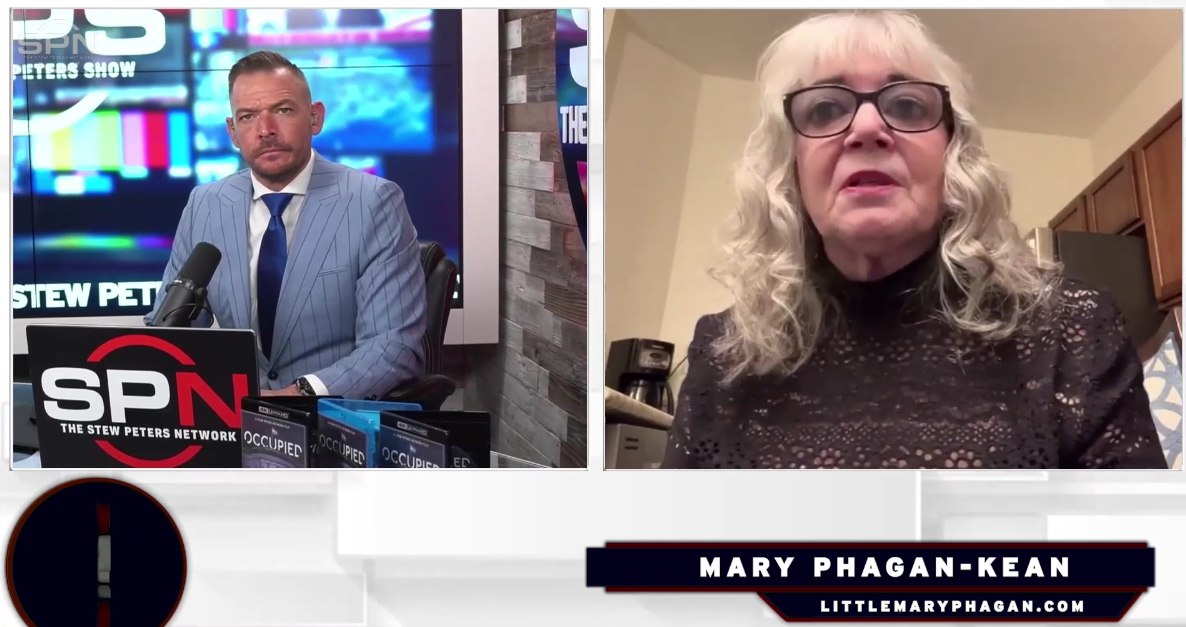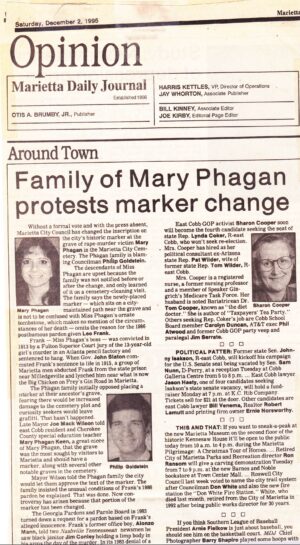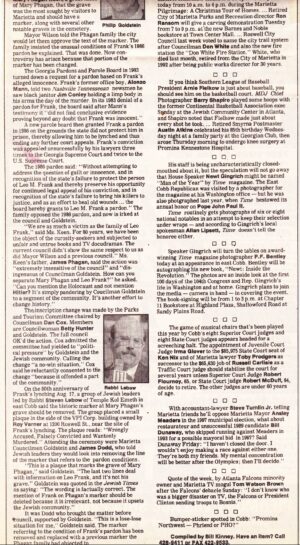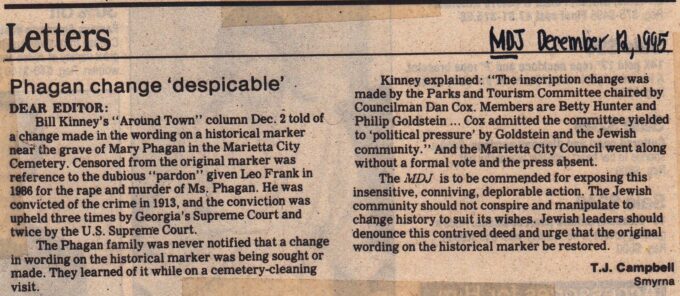by Robert Snyder
Edited by Charlotte Baker
ON March 11, 2025, Mary Phagan-Kean—the great-niece of 13-year-old Mary Phagan, who was brutally murdered in 1913 by Jewish B’nai B’rith official Leo Frank—appeared on the Stew Peters television program. You can watch the full interview by clicking the video link above.
The trial, conviction, and execution of Frank led to the creation of what is now one of the most powerful organizations in America: the Anti-Defamation League (ADL1). Since its founding, the ADL has worked to silence and punish those who expose Jewish abuses of power. Today, alongside its allies in the media, academia, and government, the ADL continues to push the false claim that Frank was an “innocent victim of anti-Semitism.” They ignore and downplay the massive amount of evidence proving his guilt. The Brief of Evidence alone is over three hundred pages long (in addition, Leo Frank’s appeals to the Georgia Supreme Court and United States Supreme Court are several thousands of pages), yet Frank’s defenders dismiss it—along with the fact that every court, from the Grand Jury to the Georgia Court of Appeals, and even the U.S. Supreme Court, upheld his conviction. This was despite Frank having some of the most skilled and well-funded attorneys of his time.
During the interview, Mrs. Phagan-Kean shares how she first learned she was related to one of America’s most well-known murder victims. She describes how, after seeing how the ADL and other Jewish groups used their vast money and influence to mislead the public into believing Frank was the victim rather than the murderer, she decided to devote her life to exposing the truth.
(In no way can Mary Phagan-Kean be called a bigot or “Jew-hater”—in fact, after her father was the leader of the color guard who honored a fallen Jewish airman, the airman’s Jewish family unofficially adopted the Phagans, and Mary always knew them affectionately as “grandma” and “grandpa.”)
Mrs. Phagan also details how Frank’s defenders have spent more than a century covering up the facts. Their tactics include:
- Framing innocent Black men. First, they tried to pin the crime on night watchman Newt Lee by planting a fake bloody shirt at his home. When that failed, they attempted to frame janitor Jim Conley by planting a fake bloody club and pay stub—and they have continued their efforts to frame Jim Conley right up to 2025. If Leo Frank were really an innocent man, would his allies and defense team have resorted to such crimes?
- Fabricating a bite mark hoax. Years after the trial, Frank’s defenders claimed that Mary Phagan’s body had “bite marks” that did not match his dental X-rays. But the official autopsy recorded no such marks, and dental X-ray analysis was not even used in Georgia courts until decades after Frank’s trial.
- Slandering Mary Phagan. Frank’s supporters attempted to smear the 13-year-old girl—whose reputation was spotless—by suggesting she was a seductress. This was a blatant attempt to shift blame away from her killer.
- Inventing the myth of an anti-Semitic trial mob. Months after the trial, Frank’s defenders falsely claimed that a violent crowd had gathered at the courtroom doors and windows, shouting, “Hang the Jew or we’ll hang you!” and the like. Contemporary photos and newspaper reports prove that no such mob ever existed.
- Tampering with historical records. Without informing the Phagan family, Frank’s supporters secretly altered the text on the historical marker at Mary Phagan’s gravesite to promote the false claim of his “innocence.”
- Holding secret meetings with government officials. As recently as 2025, Frank’s defenders have met behind closed doors with Georgia and Fulton County officials—while deliberately excluding the Phagan family, the press, and the public—to push for his official exoneration. The meeting minutes also seemingly disappear or are not taken. Mary Phagan-Kean has asked to see these and has been prevented from doing so.
And these are just a few of the deceptive tactics used in this long-running campaign to rewrite history.
Mrs. Phagan-Kean also announces that a new, expanded edition of her book, The Murder of Little Mary Phagan, will be released this year. This updated volume will include even more evidence proving Frank’s guilt, revealing the crimes and hoaxes of his defenders, and exposing the relentless effort to clear the name of a man who was rightfully convicted of the rape and murder of a 13-year-old girl.
Be sure to share this important interview with others. Understanding the forces behind the campaign to exonerate Leo Frank is key to understanding the power structures shaping the world today.
* * *
- Leo Frank was president of the Atlanta B’nai B’rith twice and was even re-elected after his conviction for the rape and strangulation of Mary Phagan. B’nai B’rith founded the ADL, originally called the Anti-Defamation League of B’nai B’rith before being shortened to just the Anti-Defamation League. The indictment, trial, and conviction of Leo Frank are what led to the founding of the ADL, not his execution, as the first announcement of its creation was on September 16th, 1913. Leo Frank was hanged in 1915.
- An interesting thing to note here is that Georgia Governor John Slaton was a partner at the same law firm as Luther Z. Rosser, Leo Frank’s defense attorney.
- Below is Defendant’s Exhibit 1, from the Brief of Evidence, showing where Leo Frank erased Newt Lee’s time stamps of 10:00 pm, 11:30 pm, 12:30 am, and 2:30 am to make it appear that he had been too busy with Mary Phagan to punch his time card:
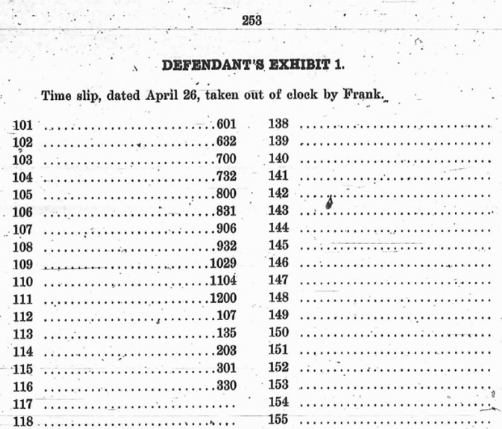
* * *
Below is the original inscription on the historical marker at Mary Phagan’s grave site where it did not hide the fact that Frank’s pardon did not officially exonerate him from the crime of murder. The newer historical marker does not provide this specific fact and implies that the pardon absolved him of the crime which is not true:

Below is what it was then changed to with no vote and no media present, in 1995. Most people, who are not well-researched in the case, would assume that “he was issued a pardon,” means that he was absolved of the crime:
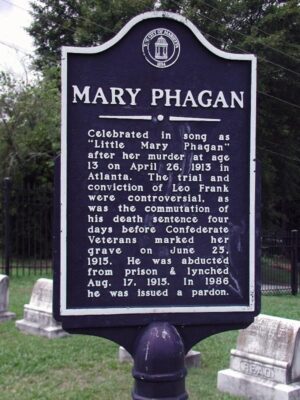
The Marietta Daily Journal published an article describing what happened and why the Phagan family was outraged by this (transcribed below):
Family of Mary Phagan protests marker change
Without a formal vote and with the press absent, Marietta City Council has changed the inscription on the city’s historic marker at the grave of rape-murder victim Mary Phagan in the Marietta City Cemetery. The Phagan family is blaming Councilman Philip Goldstein.
The descendants of Miss Phagan are upset because the family was not notified before or after the change, and only learned of it on a cemetery-cleaning visit. The family says the newly-placed marker – which sits on a city-maintained path near the grave and is not to be confused with Miss Phagan’s ornate tombstone, which makes no mention of the circumstances of her death – omits the reason for the 1986 posthumous pardon given Leo Frank.
Frank – Miss Phagan’s boss – was convicted in 1913 by a Fulton Superior Court jury of the 13-year-old girl’s murder in an Atlanta pencil factory and sentenced to hang. When Gov. John Slaton commuted Frank’s sentence to life in 1915, a group of Marietta men abducted Frank from the state prison near Milledgeville and lynched him near what is now the Big Chicken on Frey’s Gin Road in Marietta.
[Years later someone vandalized the elegant white marble flowerpot situated at the footer of the epitaph slab and stole the broken piece of it.]
The Phagan family initially opposed placing a marker at their ancestor’s grave, fearing there would be increased damage to the cemetery plot and curiosity seekers would leave graffiti. That hasn’t happened. Late Mayor Joe Mack Wilson told east Cobb resident and Cherokee County special education teacher Mary Phagan Keen, a great-niece of Mary Phagan, that the grave was the most sought by visitors to Marietta and should have a marker, along with several other notable graves in the cemetery.
[Newly concealing the fact that Leo M. Frank was not officially exonerated]
Mayor Wilson told the Phagan family the city would let them approve the text of the marker. The family insisted the unusual conditions of Frank’s 1986 pardon be explained. That was done. Now controversy has arisen because that portion of the marker has been changed.
The Georgia Pardons and Parole Board in 1983 turned down a request for a pardon based on Frank’s alleged innocence. [Leo] Frank’s former office boy, Alonzo Mann, told two Nashville Tennessean newsmen he saw black janitor Jim Conley holding a limp body in his arms the day of the murder. In its 1983 denial of a pardon for Frank, the board said after Mann’s testimony it “did not find conclusive evidence proving beyond any doubt that Frank was innocent.”
A new parole board then granted Frank a pardon in 1986 on the grounds the state did not protect him in prison, thereby allowing him to be lynched and thus ending any further court appeals. Frank’s conviction was appealed unsuccessfully by his lawyers three times to the Georgia Supreme Court and twice to the U.S. Supreme Court.
The 1986 pardon said: “Without attempting to address the question of guilt or innocence, and in recognition of the state’s failure to protect the person of Leo M. Frank and thereby preserve his opportunity for continued legal appeal of his conviction, and in recognition of the state’s failure to bring his killers to justice, and as an effort to heal old wounds…the board hereby grants to Leo M. Frank a pardon.” The family opposed the 1986 pardon, and now is irked at the council and [Philip] Goldstein.
[The Georgia Board of Pardons and Paroles failed to mention the fact that Leo Frank had fully exhausted all of his trial appeals at the Georgia and Federal Supreme Court in April of 1915.]
“We are as much a victim as the family of Leo Frank,” said Ms. Keen. For 80 years, we have been the object of the curiosity-seekers and subjected to unfair and untrue books and TV docudramas. The current council didn’t show the same respect to us as did Mayor Wilson and a previous council.” Ms. Keen’s father, James Phagan, said the action was “extremely insensitive of the council” and “disingenuous of Councilman [Philip] Goldstein. How can you separate Mary Phagan and Leo Frank?” he asked. “Can you mention the Holocaust and not mention Hitler? It’s simply pandering by Councilman [Philip] Goldstein to a segment of the community. It’s another effort to change history.”
The inscription change was made by the Parks and Tourism Committee chaired by Councilman Dan Cox. Members are Councilwoman Betty Hunter and Goldstein. The full council OK’d the action. Cox admitted the committee had yielded to “political pressure” by [Philip] Goldstein and the Jewish community. Calling the change “a no-win situation,” Cox said he reluctantly consented to the change “because it offended a part of the community.”
[August 17, 1995. Leo Frank’s Lynching Site, 1200 Roswell Road, Marietta, Cobb County, Georgia]
On the 80th anniversary of Frank’s lynching on Aug. 17, [1995] a group of Jewish leaders led by Rabbi Steven Lebow of Temple Kol Emeth in East Cobb said the historic marker at Mary Phagan’s grave should be removed. The group placed a small plaque in the side of the VPI Corp. building owned by Roy Varner at 1200 Roswell St., near the site of Frank’s lynching. The plaque reads: “Wrongly Accused, Falsely Convicted and Wantonly Murdered.” Attending the ceremony were Marietta Councilmen Goldstein and James Dodd, who told Jewish leaders they would look into removing the line of the marker that refers to the pardon conditions.
“This is a plaque that marks the grave of Mary Phagan,” said [Philip] Goldstein. “The last two lines deal with information on Leo Frank, and it’s not his grave.” Goldstein was quoted in the Jewish Times as saying: “The wording is factually correct. The mention of Frank [not getting officially exonerated] on Phagan’s marker should be deleted because it is irrelevant, not because it upsets the Jewish community.”
It was Dodd who brought the matter before council, supported by [Philip] Goldstein. “This is a lose-lose situation for me,” [Philip] Goldstein said. The marker referring to the condition of Frank’s pardon has been removed and replaced with a marker the Phagan family had objected to.
A letter to the editor regarding the incident (transcribed below):
DEAR EDITOR: Bill Kinney’s “Around Town” column December 2nd told of a change made in the wording on a historical marker near the grave of Mary Phagan in the Marietta City Cemetery. Censored from the original marker was reference to the dubious “pardon” given Leo Frank in 1986 for the rape and murder of Ms. Phagan. He was convicted of the crime in 1913, and the conviction was upheld three times by the Georgia’s Supreme Court and twice by the U.S. Supreme Court. The Phagan family was never notified that a change in wording on the historical marker was being sought or made. They learned of it while on a cemetery-cleaning visit.
Kinney explained: “The inscription change was made by the Parks and Tourism Committee chaired by Councilman Dan Cox. Members are Betty Hunter and Philip Goldstein… Cox admitted the committee yielded to ‘political pressure’ by Goldstein and Jewish Community.” And the Marietta City Council went along without a formal vote and the press absent.
The MDJ is to be commended for exposing this insensitive, conniving, deplorable action. The Jewish community should not conspire and manipulate to change history to suit its wishes. Jewish leaders should denounce this contrived deed and urge that the original wording on the historical marker be restored.
— TJ Campbell, Smyrna
